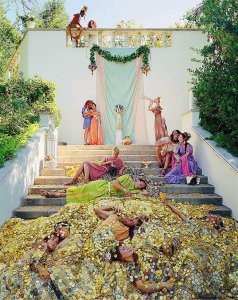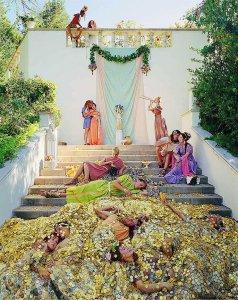Last Monday I had the pleasure of walking through art, literary, and cinematic histories with Eleanor Antin. The pioneering feminist artist was at the museum to install Classical Frieze, a video documenting three photographic series that occupied roughly eight years of her artistic output since 2000, as well as a sampling of those photographs. The occasion of Pompeii and the Roman Villa prompted discussions between the Contemporary Art curators and Antin about the prospect of showing selections from her forays into Roman history. Ironically, as Antin recounted to Artforum’s Brian Sholis back in 2008, it turns out that her path to Pompeii began on her southbound journey home from LACMA about ten years ago:
One day after my retrospective exhibition at LACMA in 1999, I was driving the scenic route down to La Jolla, and looking down at the town glittering in the sun, I suddenly had a vision that La Jolla was Pompeii. Pompeii was a very wealthy town, too; it was the place where rich people went in the summer to escape mosquito-plagued Rome. It was the place to which older senators retired if they survived Roman politics. People living there enjoyed the affluent life while on the verge of annihilation. You don’t even need to consider our current political situation to see a connection: The cliffs are eroding, we’re on a major fault line, the wildfires get worse and worse, there are water shortages. California is overbuilt and disintegrating. So we don’t have a volcano, but it could be just as bad.

Eleanor Antin, "The Golden Death," from the series "The Last Days of Pompeii," 2001
Antin considers the photographs from the three related series (Last Days of Pompeii, Roman Allegories, and Helen’s Odyssey) “still movies,” as each involve the entire apparatus of a studio production and often replicate the bathos of Hollywood’s own historical epics, but with a much more sardonic bite. The video is a document of the involved choreography perfectly illustrating how (in art historian Amelia Jones’ words) Antin “engages the past by flirting with the fake.” You can see Antin describe these "still movies" in her own words in this scene from Art21, about Helen's Odyssey:
In fact, Antin’s flirty engagement with the past goes back to her earliest series, The Angels of Mercy (1977), a meditation on the theatrical underpinnings of so-called documentary photography in which she cast herself and friends in a historical time swap supposedly set on the battlegrounds of the Crimean War. But as generally is the case in Antin’s oeuvre, there are multiple adaptations of style and genre at work. So to go back to that origin story for the Roman trilogy, you can imagine Antin driving through a landscape of postmodern architectural variations on the neo-classical in that blinding La Jolla sunshine and immediately making the mental leap to the decadence of Thomas Couture and Lawrence Alma-Tadema, not to mention that of Gore Vidal and Federico Fellini. And yet summoning all of these performative excesses together, Antin still manages to find wit and warmth amidst her evocation of our times (as modern day Romans) “living the good life on the verge of annihilation.”
Rita Gonzalez, Assistant Curator, Contemporary Art



